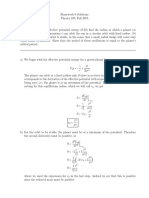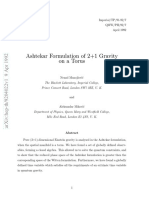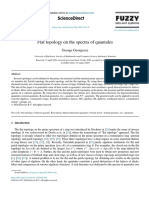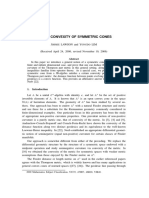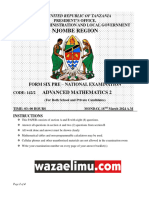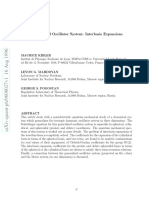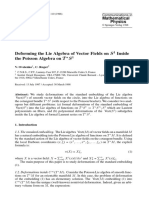Received June 8, 2007
Received June 8, 2007
Uploaded by
Dishant PandyaCopyright:
Available Formats
Received June 8, 2007
Received June 8, 2007
Uploaded by
Dishant PandyaOriginal Description:
Original Title
Copyright
Available Formats
Share this document
Did you find this document useful?
Is this content inappropriate?
Copyright:
Available Formats
Received June 8, 2007
Received June 8, 2007
Uploaded by
Dishant PandyaCopyright:
Available Formats
NON EXISTENCE OF BIANCHI TYPE V STRING COSMOLOGICAL
MODEL WITH BULK VISCOUS FLUID IN GENERAL RELATIVITY
K.S. ADHAV, A.S. NIMKAR, M.V. DAWANDE, M.R. UGALE
Department of Mathematics, SandGadge Baba Amravati University, AMRAVATI (444602)
E-mail: ati_ksadhav@yahoo.co.in
Received June 8, 2007
Bianchi type V string cosmological model with bulk viscous fluid is considered
in general relativity. It is interesting to note that cosmic strings with bulk viscous fluid
do not exist in Bianchi type V cosmology. Hence the vacuum model is constructed.
Key words: Bianchi type I space time, cosmic strings, bulk viscous fluid.
1. INTRODUCTION
Bianchi type cosmological models are important in the sence that these are
homogeneous and anisotropic, from which the process of isotropization of the
universe is studied through the passage of time. Moreover, from the theoretical
point of view anisotropic universe have a greater generality than isotropic models.
The simplicity of the field equations made Bianchi space time useful in
constructing models of spatially homogeneous and anisotropic cosmologies.
The origin of our universe is one of the greatest cosmological mysteries even
today. The exact physical situation at early stage of the formation of our universe is
still unknown. The concept of string theory was developed to describe events of the
early stage of the evolution of the universe. The general relativistic treatment of
strings was initiated by Stachel (1980) and Letelier (1983). The gravitational
effects of cosmic strings have been extensively discussed by Vilenkin (1981), Gott
(1985), Letelier (1983) in general relativity. The string cosmological models with
magnetic field are investigated by Chakraborty (1991), Tikekar & Patel (1992).
Bhattacharjee and Baruha (2001) studied the problems of cosmic strings taking
Bianchi type cosmologies with a self interacting scalar field. Cosmic strings are
important in the early stages of evolution of the universe before the particle
creation. The present day observations do not rule out the possible existence of
large scale networks of strings in the early universe. Reddy (2003) shown that, the
cosmic strings which have received considerable attension in cosmology do not
exist in the frame work of Rosens (1973) bimetric theory of gravitation.
Rom. Journ. Phys., Vol. 54, Nos. 12, P. 207212, Bucharest, 2009
K.S. Adhav et al. 2
208
The role of viscosity in cosmology has been investigated by Weinbergs
(1971), Nightingale (1973), Heller and Klimek (1975). Viscosity is important in
cosmology for a number of reasons. Misner [1967, 1968] has studied the effect of
viscosity on the evolution of cosmological models. Collins and Stewart (1971)
have studied the effect of viscosity on the formation of galaxies.
Santosh et al. (1985) obtained exact solutions for isotropic homogeneous
cosmological model with bulk viscosity. Yadav et al. (2006) have studied some
Bianchi type I Viscous fluid string cosmological models with magnetic field.
Yadav, Rai and Pradhan (2006) have found the integrability of cosmic string in
Bianchi type III space time in presence of bulk viscous fluid. Xing-Xiang Wang
(2004) discussed Kantowski Sachs string cosmological model with Bulk
Viscosity in General Relativity.
Also several aspects of viscous fluid cosmological models in early universe
have been extensively investigated by many authors. Krori and Mukherjee (2000),
Singh and Beesham (2000), Bali and Sharma (1995), Bali and Upadhaya (2003)
have discussed locally rotationally symmetric Bianchi type-I string cosmological
models with bulk viscosity. Bianchi type-V cosmological models have been
studied by other researcher, Reddy (2006), Roy and Prasad (1994), Farnsworth
(1967) in different context. Recently Pradhan et al. (2006) studied tilted Bianchi
type I cosmological models filled with disordered radiation in presence of a bulk
viscous fluid & head flow also Raj Bali & A. Pradhan (2007) have studied Bianchi
type III string cosmological models with Time dependent Bulk Viscosity.
The purpose of the present work is to obtain vacuum Bianchi type V string
cosmological model with bulk viscous fluid. Our paper is organized as follows.
In section 2, we derive the field equations and their solution in Bianchi type
V String cosmological model with bulk viscous fluid. The last section contains
some conclusions.
2. FIELD EQUATIONS OF STRING COSMOLOGICAL MODEL WITH BULK
VISCOUS FLUID
We consider the Bianchi type-V space-time in the general form
( )
2 2 2 2 2 2x 2 2
ds = dt + A dx +B e dy +dz , (1)
where A and B are functions of t only.
The energy momentum tensor for a cloud of string dust with a bulk viscous
fluid as given by Letelier (1979), Bali and Upadhaya (2003) is
( )
j j j j j
i i i ; i i
T v v x x v g v v = +
l
l
(2)
where v
i
and x
i
satisfy the condition
1 0
i i i
i i i
v v x x , v x = = = . (3)
3 String cosmological model in general relativity
209
Here is coefficient of bulk viscosity,
l
;l
= is scalar expansion, is the
proper energy density of cloud of strings with particles attached to them. is the
string tension density, v
i
is the four velocity of the particles and x
i
is a unit space-
like vector representing the direction of strings. If the particle density of the
configuration is denoted by
p
then we have
=
p
+ (4)
The Einsteins field equations with gravitational units 8 G = C = 1 read as
1
2
j j j
i i i
R Rg T = (5)
where
j
i
R is the Ricci tensor, R = g
ij
R
ij
is the Ricci scalar.
In comoving co-ordinate system, we have
(0 0 0 1)
i
v , , , = and
1
( 0 0 0)
i
x , , ,
A
= . (6)
The field equations (5) with (2) subsequently lead to the following system of
equations:
2
44 4
2
2
1
2 =( )
B B
A
B B
+ + (7)
44 44 4 4
2
1
A B A B
A
A B AB
+ + = (8)
2
4 4 4
2
2
3
2
A B B
A
AB B
+ = (9)
4 4
2 2 0
B A
B A
= (10)
where the index 4 at the symbols A and B denotes ordinary differentiation with
respect to t. The physical variables namely the scalar expansion have the
following expressions for the above metric (1):
4 4
2
A B
A B
= + (11)
From equation (10), we get A = B (12)
Without loss of generality, we can take = 1. We get, A = B. (13)
With the help of equation (1), the set of equations (7)(9), reduces to
2
44 4
2
1
2 ( )
B B
B
B B
+ = +
(14)
2
44 4
2
1
2
B B
B
B B
+ =
(15)
K.S. Adhav et al. 4
210
2
4
2
3
3
B
B
B
=
(16)
Solving equation (15), (16), we get
44
6 (3 )
B
B
= (17)
The field equations (14)(16) are highly non-linear three differential
equations in five unknown parameters B, , , , . One additional constraint
relating these parameters is required to obtain a determinate solution. Therefore,
we assume a relation between the coefficient of bulk viscosity (), scalar expansion
() and density () given by
3 = (18)
Using above equation (18) into equation (17), we have B
44
= 0 (19)
Integrating, we obtain A = B = C
1
t+C
2
(20)
where C
1
and C
2
are constants of integration.
Comparing equations (14) and (15), we get, = 0. (21)
2
1
2
1 2
3( 1)
( )
C
C t C
=
+
(22)
( )
( )
2
1
1 1 2
1
3
C
C C t C
=
+
when C
1
= 1 then we get = 0 and = 0.
= 0 & = 0 which immediately shows that cosmic strings do not occur in
Bianchi type V space time with bulk viscosity.
Hence Bianchi type V string cosmological model with bulk viscous fluid in
general relativity can be expressed as
( ) ( )
2 2
2 2 2 2 2 2
1 2 1 2
( )
x
ds dt C t C dx C t C e dy dz = + + + + +
Which can be reduced (after a proper choice of coordinates and constants) in
the form
2 2 2 2 2 2 2 2
( )
x
ds dT T dX T e dY dZ = + + + . (23)
3. STRING COSMOLOGICAL MODEL WITHOUT BULK VISCOUS FLUID
In this section we obtain a string cosmological model without bulk viscous
fluid. The field equation (5) with equation (2) (only without bulk viscous fluid at
string), lead to the following
2
44 4
2
2
1
2
B B
A
B B
+ = (24)
5 String cosmological model in general relativity
211
44 44 4 4
2
1
0
A B A B
A
A B AB
+ + = (25)
2
4 4 4
2
2
3
2
A B B
A
AB B
+ = (26)
4 4
2 2 0
B A
B A
= (27)
By the same arguments as in section 2, the equation (24)(27) reduces to
2
44 4
2
1
2
B B
B
B B
+ =
(28)
2
44 4
2
1
2 0
B B
B
B B
+ =
(29)
2
4
2
3
3
B
B
B
=
(30)
To obtain a determinate solution of the above equations (28)(30) which are
highly non-linear field equations, we assume a relation = i.e. proper energy
density for a cloud string is equal to the string tension density. (31)
From equations (28) and (29), we obtain = 0, hence = 0.
From equations (28), (30) and (31), we obtain
B
44
= 0 (32)
Integrating it, we obtain
A = B = C
3
t + C
4
(33)
where C
3
and C
4
are constants of integration.
Compairing equation (28) and (29), we obtain
= 0
= = 0 (34)
which immediately means that Bianchi type V string cosmological model do not
exist without bulk viscous fluid in general relativity. Hence in this case also we
obtain the vacuum model given by equation (23).
4. PHYSICAL AND KINEMATICAL PROPERTIES
Spatial Volume V = g = (C
1
t +C
2
)
3
e
2x
, where C
1
and C
2
are constants.
Expansion Scalar =
l
;l
= 3B
4
/ B = 3C
1
/ (C
1
t +C
2
)
Shear Scalar
2
=
2
1
1 2
7
2
C
C t C
+
K.S. Adhav et al. 6
212
Decelaration Parameter q = 0. Therefore universe is accelerating due to
introduction of bulk viscosity. As such present day observations suggest that our
universe is accelerating.
CONCLUSION
It may be noted, here, that Krori et al. (1994) have shown that in the context
of general relativity cosmic strings do not occur in Bianchi type V cosmology.
Our finding is similar to above. It is also observed that bulk viscosity plays no role
in the evolution of the universe.
REFERENCES
1. Bali R., Sharma, K., 1995, Astrophys. Space Sci., 275, 485.
2. Bali R., Upadhaya, R.D., 2003, Astrophys. Space Sci., 288, 287.
3. Bali R., Pradhan A., 2007, Accepted, gr-qc/06/018, V2.
4. Bhattacharjee, R., Baruah, K.K., 2001, Pure. Appl. Math. 32, 47.
5. Chakraborty, S., 1991, Ind. J. Pure Appl. Phys. 29, 31.
6. Collins, C.B., Stewart J.M., 1971, Mon. Not. R. Astron. Soc. 153, 419.
7. Farnsworth, D.L., 1967, J. Math. Phys. 8, 2315.
8. Gott, J.R., 1985, Ap. Phys. J., 288, 422.
9. Heller, M., Klimek, Z., 1975, Astrophys. Space Sci., 33, 37.
10. Krori, K.D., Chaudhary, T., Mahanta, C.R., 1994, Gen. Rel. Gra. 26, 265.
11. Krori, K.D., Mukherjee A., 2000, Gen. Rel. Gra. 32, 1429.
12. Letelier, P.S., 1983, Phys. Rev. D. 28, 2414.
13. Letelier, P.S., 1979, Phys. Rev. D. 20, 1294.
14. Misner, C.W., 1967, Nature 214, 40.
15. Misner, C.W., 1968, Astrophys. J. 151, 431.
16. Nightingale, J.P., 1973, Astrophys. J., 185, 105.
17. Pradhan A., Rai., A., 2006, gr-qc/0212108 V1.
18. Reddy, D.R.K., 2003, Astrophys. Space Sci., 286, 397400.
19. Reddy D.R.K., Rao, M.V.S., Rao G.K., 2006, Astrophys. Space Sci. (Communicated).
20. Rosens N., 1973, Gen. Rel. Grav., 4, 435.
21. Roy, S.R., Prasad A., 1994, Gen. Rel. Grav. 26, 939.
22. Santosh, N.O., Dias, R.S., Banerjee A., 1985, J. Math. Phys. 26, 878.
23. Singh T., Beesham A., 2000, Gen. Rel. Grav. 32,607.
24. Stachel, J., 1980, Phys. Rev. D 21, 2171.
25. Tikekar, R., Patel, L.K., 1992, Gen.Rel. Grav., 24, 397.
26. Vilenkin, A., 1981, Phys. Rev. D 23, 852.
27. Weinberg, S., 1971, Astrophys. J. 168, 175.
28. Yadav, M.K., Rai A. and Pradhan, A., 2006, Int. J. Theory Phys. Accepted, Preprint gr-
qc/0611032.
29. Wang, Xing Xiang, 2004, Astrophy. Space Sci., XXX, 18.
You might also like
- Topics in Propagation of Chaos - SznitmanDocument87 pagesTopics in Propagation of Chaos - SznitmanNicoleta CazacuNo ratings yet
- Sol 6Document13 pagesSol 6akjsdnfNo ratings yet
- Introduction To University Mathematics MATH40001/MATH40009 Problem Sheet 0Document2 pagesIntroduction To University Mathematics MATH40001/MATH40009 Problem Sheet 0sample textNo ratings yet
- Treatment Approaches in Management of StutteringDocument46 pagesTreatment Approaches in Management of StutteringKUNNAMPALLIL GEJO JOHN100% (2)
- An Eccentric Ghost in The Machine Formal and Quantitative Aspects of The Sā Khya - YogaDocument16 pagesAn Eccentric Ghost in The Machine Formal and Quantitative Aspects of The Sā Khya - YogaLangravio Faustomaria PanattoniNo ratings yet
- Sam Ant ADocument18 pagesSam Ant ARigoberto CervantesNo ratings yet
- !!! - Lapitski2011 - Convergence of A Three-Dimensional Quantum Toward Dirac EqDocument9 pages!!! - Lapitski2011 - Convergence of A Three-Dimensional Quantum Toward Dirac EqTheo KNo ratings yet
- Real and Complex Connections For Canonical Gravity: Home Search Collections Journals About Contact Us My IopscienceDocument6 pagesReal and Complex Connections For Canonical Gravity: Home Search Collections Journals About Contact Us My IopsciencePatrick WongNo ratings yet
- Msci Examination: Phy-415 (Msci 4242) Relativistic Waves and Quantum FieldsDocument7 pagesMsci Examination: Phy-415 (Msci 4242) Relativistic Waves and Quantum FieldsRoy VeseyNo ratings yet
- The Coupled Higgs Field EquationsDocument14 pagesThe Coupled Higgs Field EquationsMustafa mızrakNo ratings yet
- Physics - I - Phy 1001 - 2023Document4 pagesPhysics - I - Phy 1001 - 2023AAYUSHMANNo ratings yet
- Spectral Symmetry in Lattice Dynamical Models: J. List. Maths Applies (1968) 4, 375-398Document24 pagesSpectral Symmetry in Lattice Dynamical Models: J. List. Maths Applies (1968) 4, 375-398jtorerocNo ratings yet
- Dirac AlgebraDocument29 pagesDirac AlgebraDaniel Julián Cárdenas OrtizNo ratings yet
- Ashtekar Formulation of 2+1 Gravity On A TorusDocument15 pagesAshtekar Formulation of 2+1 Gravity On A TorusCutelaria SaladiniNo ratings yet
- Andrea Raspini - Massive Particles With de Finite ChiralitiesDocument3 pagesAndrea Raspini - Massive Particles With de Finite ChiralitiesOptimuszNo ratings yet
- 96gravit Dynamics ProcsDocument18 pages96gravit Dynamics ProcsyasiribrahimferozmullaNo ratings yet
- Mathematical Theory of Nonlinear Single-Phase PoroelasticityDocument41 pagesMathematical Theory of Nonlinear Single-Phase PoroelasticityAxel DorianNo ratings yet
- Dirac Oscillator Interacting With A Topological Defect: 10.1103/physreva.84.032109Document6 pagesDirac Oscillator Interacting With A Topological Defect: 10.1103/physreva.84.032109tridevmishraNo ratings yet
- RG CW 14Document7 pagesRG CW 14Roy VeseyNo ratings yet
- On Some Equivalence Problems For Differential EquationsDocument13 pagesOn Some Equivalence Problems For Differential EquationsPanagiot LoukopoulosNo ratings yet
- Vacuum Einstein Equations in Terms of Curvature Forms: Home Search Collections Journals About Contact Us My IopscienceDocument19 pagesVacuum Einstein Equations in Terms of Curvature Forms: Home Search Collections Journals About Contact Us My IopsciencePatrick WongNo ratings yet
- Sri Chaitanya JEE-Main - Shift-02 - 04-04-2024 - Question PaperDocument10 pagesSri Chaitanya JEE-Main - Shift-02 - 04-04-2024 - Question PaperNick SinghNo ratings yet
- 2016 SRP ChladniDocument4 pages2016 SRP ChladniFrane DuiloNo ratings yet
- String Topology: Moira Chas and Dennis Sullivan October 24, 2003Document34 pagesString Topology: Moira Chas and Dennis Sullivan October 24, 2003Moira ChasNo ratings yet
- Different Nonlinearities To The Perturbed Nonlinear SCHR Dinger Equation Main IdeaDocument4 pagesDifferent Nonlinearities To The Perturbed Nonlinear SCHR Dinger Equation Main Ideasongs qaumiNo ratings yet
- Advance Dynamics 2021Document3 pagesAdvance Dynamics 20219153am735443No ratings yet
- Msci Examination: Phy-415 (Msci 4242) Relativistic Waves and Quantum FieldsDocument7 pagesMsci Examination: Phy-415 (Msci 4242) Relativistic Waves and Quantum FieldsRoy VeseyNo ratings yet
- Flat Topology On The Spectra of QuantalesDocument20 pagesFlat Topology On The Spectra of QuantalesKamal El-SaadyNo ratings yet
- CU-2022 B.Sc. (Honours) Physics Semester-3 Paper-CC-5 QPDocument3 pagesCU-2022 B.Sc. (Honours) Physics Semester-3 Paper-CC-5 QPSAYAN GHOSHNo ratings yet
- PeskinDocument714 pagesPeskinShuchen Zhu100% (1)
- Ragazzo-Ruiz2017 Article ViscoelasticTidesModelsForUseIDocument41 pagesRagazzo-Ruiz2017 Article ViscoelasticTidesModelsForUseIVishnu ViswanathanNo ratings yet
- 3rd Year Paper VIIIDocument3 pages3rd Year Paper VIIIAnjan DasNo ratings yet
- Spheres and Ehresmann ConnectionDocument55 pagesSpheres and Ehresmann ConnectionMike AlexNo ratings yet
- Levi-Civita Space Times in Multidimensional TheoriesDocument7 pagesLevi-Civita Space Times in Multidimensional TheoriesFausto Intilla100% (1)
- Distance-Redshift Relations in An Anisotropic Cosmological ModelDocument8 pagesDistance-Redshift Relations in An Anisotropic Cosmological ModelzrbutkNo ratings yet
- Physics - I-Phys 1001-2023Document4 pagesPhysics - I-Phys 1001-2023xilag49210No ratings yet
- 2te Bereicht EntwurfDocument15 pages2te Bereicht EntwurfmandbackNo ratings yet
- Phy 311 Question Bank 2023Document3 pagesPhy 311 Question Bank 2023williamscoaplandNo ratings yet
- (DE 101) B.Tech. Degree Examination, May 2007: Mxydx NxydyDocument16 pages(DE 101) B.Tech. Degree Examination, May 2007: Mxydx NxydyvaavillsNo ratings yet
- Metric Convexity of Symmetric Cones: Lawson, J. and Lim, Y. Osaka J. MathDocument22 pagesMetric Convexity of Symmetric Cones: Lawson, J. and Lim, Y. Osaka J. MathSangat BaikNo ratings yet
- Topological Aspect of Disclinations in Two-Dimensional MeltingDocument6 pagesTopological Aspect of Disclinations in Two-Dimensional MeltingBayer MitrovicNo ratings yet
- Classical Dynamics: Example Sheet 1: Comments Welcome: Please Send Them To Berry Groisman (bg268@)Document4 pagesClassical Dynamics: Example Sheet 1: Comments Welcome: Please Send Them To Berry Groisman (bg268@)Shweta SridharNo ratings yet
- Maxwell's Equations in 4-Dimensional Euclidean Space: Jos e B. AlmeidaDocument13 pagesMaxwell's Equations in 4-Dimensional Euclidean Space: Jos e B. AlmeidaSumihar SimangunsongNo ratings yet
- Time Allotted: 3 Hrs Full Marks: 70Document6 pagesTime Allotted: 3 Hrs Full Marks: 70Vikash KumarNo ratings yet
- 11 FIRST Revision Question and Answer 2022 EMDocument12 pages11 FIRST Revision Question and Answer 2022 EMMuthu SelvamNo ratings yet
- Adv Math 02Document4 pagesAdv Math 02chemistryfvNo ratings yet
- Anisotropic Bianchi Type VI Cosmological Models in A ModifiedDocument14 pagesAnisotropic Bianchi Type VI Cosmological Models in A ModifiedShubhangi ChouguleNo ratings yet
- A Class of Exact Solutions of The Liénard-Type Ordinary Nonlinear Differential EquationDocument13 pagesA Class of Exact Solutions of The Liénard-Type Ordinary Nonlinear Differential EquationBashar MayyasNo ratings yet
- Research PaperDocument13 pagesResearch PaperScott JacksonNo ratings yet
- 2407 14647v1Document17 pages2407 14647v1thirdquaternionNo ratings yet
- Boundary Value Problems For Nonlinear Second-Order Vector Differential EquationsDocument13 pagesBoundary Value Problems For Nonlinear Second-Order Vector Differential EquationsAdrian Calin MurzaNo ratings yet
- Propagation of Love Waves in An Elastic Layer With Void PoresDocument9 pagesPropagation of Love Waves in An Elastic Layer With Void Poresmadhumitakundu1976No ratings yet
- Beckers1995 Leer3Document14 pagesBeckers1995 Leer3Gss PpiNo ratings yet
- X-Ray Diffraction - Open Solid State NotesDocument15 pagesX-Ray Diffraction - Open Solid State NoteschloeNo ratings yet
- Motion SchwarzchildGeomDocument61 pagesMotion SchwarzchildGeomSolomon AntoniouNo ratings yet
- Njombe Pre Necta IIDocument4 pagesNjombe Pre Necta IIbrigittawilliam764No ratings yet
- Advanced Maths 2Document4 pagesAdvanced Maths 2youngtillionez99No ratings yet
- MSC Physics - Part-I - Part-IIDocument16 pagesMSC Physics - Part-I - Part-IIRahul Kumar SharmaNo ratings yet
- On A Generalized Oscillator System: Interbasis ExpansionsDocument23 pagesOn A Generalized Oscillator System: Interbasis Expansionstestonly261No ratings yet
- OvsienkoRoger DeformingLieAlgrebraVectorFieldsS1 CommMathPhys PDFDocument14 pagesOvsienkoRoger DeformingLieAlgrebraVectorFieldsS1 CommMathPhys PDFhelmantico1970No ratings yet
- OverviewDocument34 pagesOverviewApple LiuNo ratings yet
- Electric and Magnetic Fields From A Circular Coil Using Elliptic Integrals (Datta)Document10 pagesElectric and Magnetic Fields From A Circular Coil Using Elliptic Integrals (Datta)Jason UchennnaNo ratings yet
- Semester II 2017Document15 pagesSemester II 2017Dishant PandyaNo ratings yet
- Semester III 2017Document13 pagesSemester III 2017Dishant PandyaNo ratings yet
- Applications of Linear Algebra in Real World Problems - Direct Presentation..ppsxDocument32 pagesApplications of Linear Algebra in Real World Problems - Direct Presentation..ppsxDishant PandyaNo ratings yet
- Serge Lang - Real-And-Functional-Analysis PDFDocument596 pagesSerge Lang - Real-And-Functional-Analysis PDFEduardo Palancares100% (3)
- A Class of Conformally Flat Solutions For Systems Undergoing Radiative Gravitational CollapseDocument15 pagesA Class of Conformally Flat Solutions For Systems Undergoing Radiative Gravitational CollapseDishant PandyaNo ratings yet
- Plotting and Graphics Options in Mathematica: The Plot CommandDocument19 pagesPlotting and Graphics Options in Mathematica: The Plot CommandDishant PandyaNo ratings yet
- Form-Hrdg-Csir: Form-C Council of Scientific and Industrial ResearchDocument4 pagesForm-Hrdg-Csir: Form-C Council of Scientific and Industrial ResearchDishant PandyaNo ratings yet
- Assignment 3Document2 pagesAssignment 3Dishant Pandya100% (1)
- 1998 by Tong and Yang - Generation of Identical Noncircular Pitch Curves 1Document5 pages1998 by Tong and Yang - Generation of Identical Noncircular Pitch Curves 1Dishant PandyaNo ratings yet
- P 0, Whose Repeated Null Congruence Is Geodesic With Zero Expansion and Shear"Document6 pagesP 0, Whose Repeated Null Congruence Is Geodesic With Zero Expansion and Shear"Dishant PandyaNo ratings yet
- Inhomogeneous Imperfect Fluid Spherical Models Without Big-Bang SingularityDocument5 pagesInhomogeneous Imperfect Fluid Spherical Models Without Big-Bang SingularityDishant PandyaNo ratings yet
- A Class of Charged Relativistic SpheresDocument9 pagesA Class of Charged Relativistic SpheresDishant PandyaNo ratings yet
- This Little CornerDocument17 pagesThis Little Cornerchim.chimNo ratings yet
- Chapter 1Document8 pagesChapter 1Miguel RuedaNo ratings yet
- 1St Quarter Examination Mapeh 3: Arts MULTIPLE CHOICE. Direction: Encircle The Letter of The Correct AnswerDocument2 pages1St Quarter Examination Mapeh 3: Arts MULTIPLE CHOICE. Direction: Encircle The Letter of The Correct Answeraldrin barnizoNo ratings yet
- FrameworkDocument2 pagesFrameworkVienoi ISUNo ratings yet
- Types of Sentences Lesson PlanDocument3 pagesTypes of Sentences Lesson PlanJen70% (27)
- Usa - Language Culture Customs and Etiquette Global-Etiquette ResourcesDocument5 pagesUsa - Language Culture Customs and Etiquette Global-Etiquette Resourcesapi-244207843100% (1)
- (Machado & Silva, 2007) Toward A Richer View of The Scientific Method PDFDocument11 pages(Machado & Silva, 2007) Toward A Richer View of The Scientific Method PDFDesmond HumeNo ratings yet
- Freedman Facilitation PacketDocument16 pagesFreedman Facilitation Packetapi-340734627No ratings yet
- Interference of Light Waves PDFDocument29 pagesInterference of Light Waves PDFSGNo ratings yet
- Indian EthosDocument4 pagesIndian Ethosfarha khanNo ratings yet
- Recollecting and Re-Collecting: The Ethical Challenges of Social Archiving in Post-Con Ict Northern IrelandDocument2 pagesRecollecting and Re-Collecting: The Ethical Challenges of Social Archiving in Post-Con Ict Northern IrelandAssmaa HassanNo ratings yet
- Emerging Management Issues and ChallengesDocument24 pagesEmerging Management Issues and ChallengesAshish GargNo ratings yet
- The Hazards of MoviegoingDocument6 pagesThe Hazards of MoviegoingChimey SailomoonNo ratings yet
- William Golding - Lord of The FliesDocument16 pagesWilliam Golding - Lord of The Fliesonutchka8479100% (1)
- Hindu Creation Myths Over TimeDocument12 pagesHindu Creation Myths Over TimeJeffrey RableNo ratings yet
- Functions of ManagementDocument11 pagesFunctions of ManagementMark Adrian Jintalan ManzanoNo ratings yet
- Uts 4Document7 pagesUts 4marochelle lleraNo ratings yet
- 60Y0 InterviewDocument24 pages60Y0 InterviewGabriel HawkeNo ratings yet
- Dimensions of Service QualityDocument4 pagesDimensions of Service QualitydoticheeNo ratings yet
- Charu Mazumdar - CollectionDocument69 pagesCharu Mazumdar - Collectionkarthik arunmozhiNo ratings yet
- Chapter 1: The Power of LuckDocument7 pagesChapter 1: The Power of LuckEinah EinahNo ratings yet
- Incompany Seced Upper Intermediate MpoDocument8 pagesIncompany Seced Upper Intermediate MpopathmotionNo ratings yet
- Professional Communication - Notes: Levels & Barriers of CommunicationDocument8 pagesProfessional Communication - Notes: Levels & Barriers of CommunicationRishavNo ratings yet
- 2-Track Method Teachers Trainers Guide 2013Document12 pages2-Track Method Teachers Trainers Guide 2013Lyn RomeroNo ratings yet
- CQ Compatibility QuotientDocument11 pagesCQ Compatibility Quotientpanayot_arNo ratings yet
- Qualitative Inquiry: Grounded Theory in Global Perspective: Reviews by International ResearchersDocument12 pagesQualitative Inquiry: Grounded Theory in Global Perspective: Reviews by International ResearchersenviNo ratings yet
- TIME - An Understanding From Bhagavad GitaDocument6 pagesTIME - An Understanding From Bhagavad GitaSowmya SathishNo ratings yet

